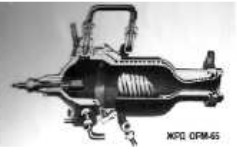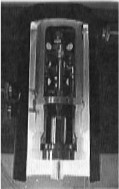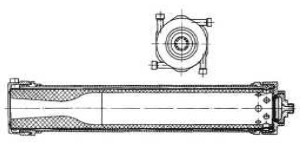Updated: 03-May-2021
This is the Russian Group for the Study of Reactive Motion, founded in 1924 by Tsander. Korolev followed him in office. There were two groups, one in Leningrad and the other in Moscow.
-The first projects were on rocket engines with liquid fuel, tested on rockets such as Gird-09 and Gird-X.

“Gird-09”
-The engines came out from GDL that was the Gas Dynamics Laboratory, directed by Glushko (see).

“Glushko ORM-65”
-Although the first engine delivered to the Gird for testing would be the ORM-1. In parallel, Tsander also designed his engine, the OR-2.

“Gird OR-2”
-It delivered 50 Kgf. of thrust for only 30 seconds.
-The Gird-05, 07 and 09 rockets were successful. The first one had Grossko's ORM-50 engine.

"Two engines used by the Gird"
-The famous rockets launched in multiple assemblies from trucks, tanks, platforms, etc., used in WWII massively by the Russians and which were called Katiushas, came from Gird. See Katiusha.
From Appendix 6: It was the Jet Propulsion Study Group. Later it would become the RN II or the Rocket Research Institute.
-The projects initiated by GDL were continued by RN II (Jet Propulsion Research Inst.).
-As in the case of the rocket 09 that ran on "condensed fuel" or hybrid, that is, it used a kind of condensed gasoline based on a solution of natural resin and "colophony" dissolved in benzine. The oxidizer was liquid oxygen.

“Rocket number 09”
-At RN II the 05 was developed with the ORM-50 engine from GDL. They also developed the 07 with the same engine.

“Rocket number 05”
-Under the guidance of Tsander (see) engines like the OR-1 were made to experiment with liquid fuels. At the time when Korolev was head of the GIRD the OR-2 was tested on a glider (the RP-1)

“GIRD OR-2 engine”
-This engine and its derivative GIRD-Kh were tested around the year 1933.
-The following year, 1934, the team formed by Korneyev, Polyarny and Dushkin (see) made the KPD-1 rocket that ran on liquid fuels. Feeding by tank pressurization. They used ethyl alcohol and liquid oxygen.

“KPD-1 rocket”
-These projects were active in Russia ten years before the German V-2 were operational. They had the same principles, the same fuels and even the shapes were the same. The difference was the size as the KPD-1 had a length of 3.30 meters.
-The following year, or almost-between 1934-1935, the Osoaviakhim came out, similar to the previous one but more developed.

“The Osoaviakhim and engine details”
-Another facet of the GIRD was the study on ramjets (Ram-Jets). This program started in 1933.
In fact, they were a variant of what we generally understand as ramjets: they went inside of projectiles that were fired with a cannon.
-In fact it was self-propelled ammunition.
-At least five designs were made. The most surprising thing about GIRD is that they made the first artifacts that passed the speed of sound.
-Below we see some of these designs:

“GIRD model 2”


“GIRD models 4 and 5”

"Two variants of model 6"
Engines of GIRD
Model: Estudios sobre ramjets (6 modelos)
Arquitecture:
Chambers:
Fuels:
Feed System:
Ignition:
Thrust:
Weight:
Model: Gird-Kh
Arquitecture:
Chambers:
Fuels:
Feed System:
Ignition:
Thrust:
Weight:
Model: Motor del Gird-05
Arquitecture:
Chambers:
Fuels:
Feed System:
Ignition:
Thrust:
Weight:
Model: motor del Gird-09
Arquitecture:
Chambers:
Fuels:
Feed System:
Ignition:
Thrust:
Weight:
Model: Motor del Gird-X
Arquitecture:
Chambers:
Fuels:
Feed System:
Ignition:
Thrust:
Weight:
Model: Motor del KPD-1
Arquitecture:
Chambers:
Fuels:
Feed System:
Ignition:
Thrust:
Weight:
Model: Motor del Osoaviakhim
Arquitecture:
Chambers:
Fuels:
Feed System:
Ignition:
Thrust:
Weight:
Model: Motor ORM-50 del Gird-07
Arquitecture:
Chambers:
Fuels:
Feed System:
Ignition:
Thrust:
Weight:
Model: OR-2 (ver Tsander)
Arquitecture:
Chambers:
Fuels:
Feed System:
Ignition:
Thrust:
Weight:
Model: ORM-1
Arquitecture:
Chambers:
Fuels:
Feed System:
Ignition:
Thrust:
Weight:


